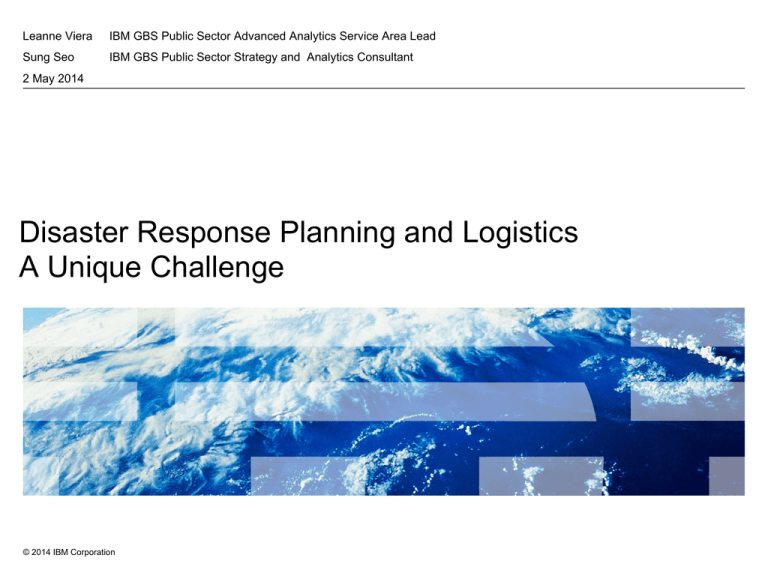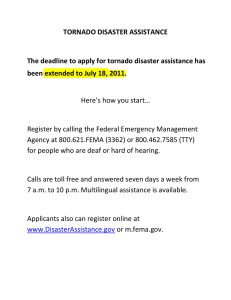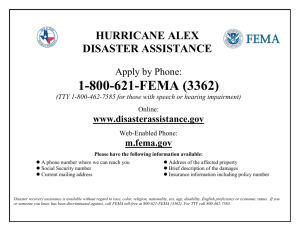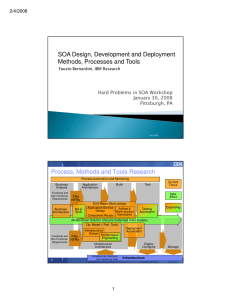Leanne Viera IBM GBS Public Sector... Sung Seo IBM GBS Public Sector Strategy and Analytics Consultant
advertisement

Leanne Viera IBM GBS Public Sector Advanced Analytics Service Area Lead Sung Seo IBM GBS Public Sector Strategy and Analytics Consultant 2 May 2014 Disaster Response Planning and Logistics A Unique Challenge © 2014 IBM Corporation The requirements for response to disasters is growing 200 Total Disasters Major Disasters 100 2013 2010 2007 2004 2001 1998 1995 1992 1989 1986 1983 1980 1977 1974 1971 1968 1965 1962 1959 1956 1953 0 § Most don’t realize the number of national disasters each year and the full requirements of a response § What is the timeframe that drive the response timeline? § What impact does policy have? § To what extent should survivors be considered self sufficient? 2 © 2014 IBM Corporation Pandemic capability to respond to multiple Katrina disasters regardless of their severity Synchronized 9/11 Disaster Density § Density: Scaling responses to account for variances in populations and infrastructure impacted by the Andrew Collaborative Ike So Cal Fires Integrated Maturity Arcs § Multiplicity: Maintaining the High Examining a framework for looking at Disaster Surge Requirements Gustav disaster Oklahoma City Functional § Intensity: Adapting responses to of varying intensities 3 Tornadoes Static Low provide adequate support to disasters Hannah Disaster Intensity Low High © 2014 IBM Corporation The objective of supply chain disaster response is theoretically simple…but operationally and organizationally complex Survival Needs coupled with a hoarding mentality Transportation with damaged infrastructure and constrained fuel Supplier Capacity if number of functioning suppliers is reduced Inventory Planning Safety Stock for multiple sequential or simultaneous disasters Distribution with law enforcement restrictions and constraints due to damage or looting Uncertain disaster density, intensity, and multiplicity These challenges defy blanket application private sector best practice and defy translation of requirements and complexities into a traditional model 4 © 2014 IBM Corporation Intense public scrutiny only intensifies the pressure “Tons of Food Spoiled As FEMA Ran Out Of Storage Space” (Washington Post, 4/12/07) “Food stored by FEMA spoils” (United Press International, 4/13/07) “Stockpiled Food Goes Bad” (CNN: The Situation Room, 4/13/07) “FEMA let millions of meals rot on Gulf Coast” (Washington Post, 4/13/07) “FEMA Wastes $40 Million in Food for Katrina” (CBS News, 4/13/07) “Another FEMA goof” (Bradenton Herald, 4/26/07) “Pre-Prepared Meals Wasted” (CNN: American Morning, 4/26/07) “FEMA To Melt $24 Million In Unused Ice” (Congressional Quarterly 7/16/07) “FEMA Ice Goes To Waste” (WVUE-TV-New Orleans 7/4/07) “FEMA Dumps Ice In Storage” (FOX Report, 7/4/07) “Doesn’t FEMA Know There Are Starving Children? $40 million in Food Thrown Away” (Associated Content, 4/13/07) 5 © 2014 IBM Corporation No matter the preparation, there will always be the unknown and unexpected 6 © 2014 IBM Corporation Competitive Advantage Applying analytics to the landscape of disaster response Stochastic Optimization How can we achieve the best outcome including the effects of variability? Optimization How can we achieve the best outcome? Predictive modeling What will happen next if ? Forecasting What if these trends continue? Simulation What could happen…. ? Alerts What actions are needed? Query/drill down What exactly is the problem? Ad hoc reporting How many, how often, where? Standard Reporting What happened? Degree of Complexity 7 Prescriptive Predictive Descriptive Based on: Competing on Analytics, Davenport and Harris, 2007 © 2014 IBM Corporation Disaster Supply Chain Response Simulation © 2014 IBM Corporation Defining a model to address the supply chain challenge Challenge Distribute emergency supplies such as water, meal, blankets, generators and tarps to disaster victims in the event of various natural and man-made disasters in a timely and effective manner to save and sustain lives, minimize suffering, and protect property Technical Solution Agent-based simulation • Simulate the flow of emergency supplies and optimize the selection of shipment destinations and cross-shipping between distribution points Benefits • Assess the effectiveness of disaster response plan for distributing emergency supplies to disaster victims • Evaluate the impact of transformation/ improvement initiatives • Identify bottlenecks, risks and improvement opportunities • Provide decision support for developing an effective disaster response plan Large-scale logistics optimization algorithms • Optimized cargo or personnel movements to maximize time-definite delivery at lowest overall logistics costs Web-enabled dashboard • Geographic information system (GIS) for capturing, managing, analyzing, and displaying geographically referenced information. 9 © 2014 IBM Corporation New Madrid Scenario Intra-plate earthquake in the southern and mid-western United States • Earthquake occurs at 2:00 AM on February 7th • Event represents rupture of three New Madrid Fault segments simultaneously with magnitude, Mw = 7.7 • Modeled as sequenEal rupture of individual segments similar to 1811-­‐1812 series of events over several months • Severe shaking occurs throughout western Kentucky, Tennessee, southeastern Missouri, northeastern Arkansas and southern Illinois with localized amplificaEon of ground shaking due to variaEons in soil condiEons • Significant ground deformaEons likely in soO soils, parEcularly near riverbeds • AOershocks around magnitude 6, ~Mw 6, are likely in the days and weeks aOer the main shock FEMA Region State Alabama Kentucky Region IV Mississippi Tennessee Total RIV Illinois Region V Indiana Total RV Arkansas Region VI Total RVI Missouri Region VII Total RVIi Total Water Liters Truckloads 1,823,169 2,641,557 2,225,166 6,765,444 13,455,336 2,044,269 1,755,087 3,799,356 3,045,516 3,045,516 2,706,450 2,706,450 102 147 124 376 749 114 98 212 169 169 150 150 3,500 Truckloads of CommodiPes 23 M liters of water 15.3 M MREs Commodities (First 72 hours) MREs Ice Number Truckloads Pounds Truckloads 1,215,446 1,761,038 1,483,444 4,510,296 8,970,224 1,362,846 1,170,058 2,532,904 2,030,344 2,030,344 1,804,300 1,804,300 56 81 68 207 412 63 54 117 93 93 83 83 4,861,784 7,044,152 5,933,776 18,041,184 35,880,896 5,451,384 4,680,232 10,131,616 8,121,376 8,121,376 7,217,200 7,217,200 122 176 148 451 897 136 117 253 203 203 180 180 23,006,658 1,280 15,337,772 705 61,351,088 1,533 Impacted Counties (IC) Alabama Arkansas Illinois Indiana Kentucky Mississippi Missouri* Tennessee Total IC Water MREs Liters Truckloads Number Truckloads -­‐ 1,646,337 1,304,613 521,913 1,073,664 1,162,497 2,227,620 4,713,111 12,649,755 -­‐ 92 68 27 92 65 119 262 723 -­‐ 1,097,558 869,742 347,942 715,776 774,998 1,485,080 3,142,074 8,433,170 -­‐ 68 34 12 33 36 68 145 396 Ice Pounds Truckloads -­‐ 4,390,232 3,478,968 1,391,768 2,863,104 3,099,992 5,940,320 12,568,296 33,732,680 -­‐ 148 81 30 72 77 148 314 872 Source: New Madrid Seismic Zone Catastrophic Event Planning Project. Mid America Earthquake Center, Virginia Tech, George Washington University (2010) 10 © 2014 IBM Corporation Modeling Challenges for Disaster Response Goals – Best possible coverage – Allocation/Adjudication – Transportation planning and scheduling – Sensitivity analysis Challenging Factors – Non-stationary demands and unstable supply chains – Uncertain/unknown demands and capacities – Multiple sourcing from dynamic supply points – Joint sourcing and transportation decisions with disruptions – Adjudication/Allocation for fairly balancing coverage 11 © 2014 IBM Corporation New Madrid Scenario Coverage simulation: Sample Snapshot 12 © 2014 IBM Corporation Key Takeaways § There is no perfect solution – Mitigation of damage – the magnitude and timing of the disaster prevents perfect coverage – Application of sophisticated analytic techniques could help drive coverage improvements of up to 9.6% leading to an estimated 57.1% coverage for the given scenario constraints. – Seemingly modest improvement would still result an additional 1.5M days of water rations with improved distribution § Location flexibility and additional scalability of potential distribution of staging areas can drive substantial improvements § Scalability of supply capacity becomes both a critical success factor and challenge 13 © 2014 IBM Corporation Mobile adoption continues to explode 41% Compound Annual Growth Rate (CAGR) Wearable Wireless Devices 1 Trillion Connected Sensors B2C B2B B2E 5.6 Billion Personal Devices Sold 2013 2014 M2M 2015 Source: ABI Research, Cisco ‘The Internet of Things: How the Next Evolution of the Internet is Changing Everything’, Cisco Visual Networking Index (VNI) Global Mobile Data Traffic Forecast for 2010-2015, IBM Analysis 14 © 2014 IBM Corporation The onset of social and mobile presents a wide range of new opportunities § Mobile represents a shift from a hardened infrastructure to one more individual and flexible – Provides an avenue to push and receive real time information immediately – Can be used to identify and locate victims in need § Hurricane Sandy showed the power utilizing mobile and social media to generate and transmit data – Agencies pushed information through twitter and Facebook and manage information – FEMA and the Red Cross mined tweets and posts for actionable information that were out to response teams – Disaster reporter apps receive structured disaster reports 15 © 2014 IBM Corporation Applying analytics to growing amounts of unstructured data to glean insights? § How much do we leave untapped if we don’t go after the unstructured data? § What innovative applications can we apply to drive more effective disaster response? § What are the challenges that come with the data? 16 © 2014 IBM Corporation Thank you! § Leanne Viera, IBM Partner, viera@us.ibm.com § Sung Seo, IBM Senior Managing Consultant, sungseo@us.ibm.com © 2014 IBM Corporation







